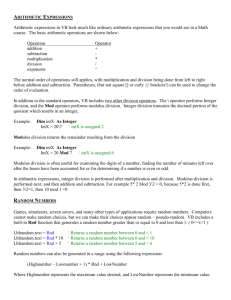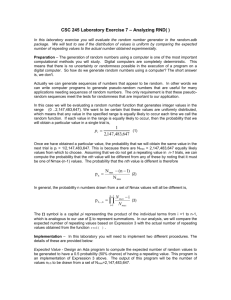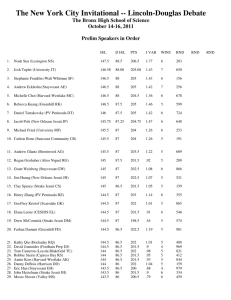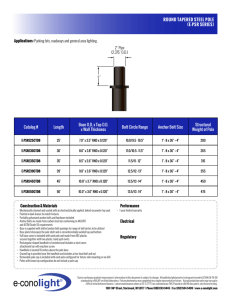PARAMETRIX TECHNIQUES AND MARTINGALE PROBLEMS FOR SOME DEGENERATE KOLMOGOROV EQUATIONS
advertisement
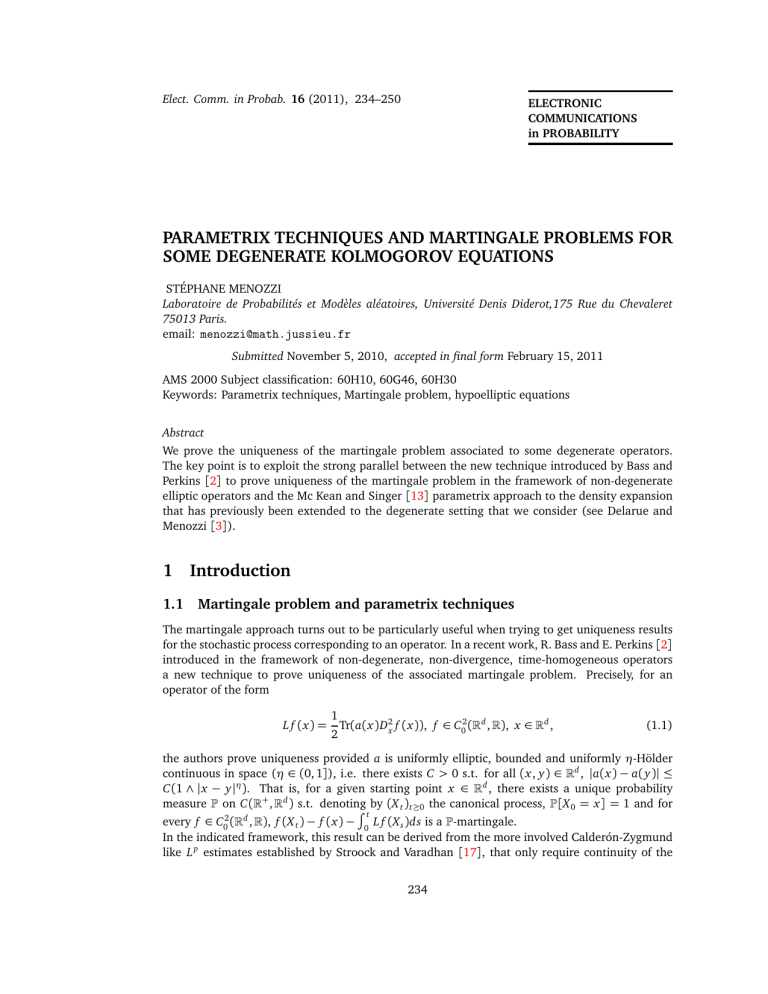
Elect. Comm. in Probab. 16 (2011), 234–250
ELECTRONIC
COMMUNICATIONS
in PROBABILITY
PARAMETRIX TECHNIQUES AND MARTINGALE PROBLEMS FOR
SOME DEGENERATE KOLMOGOROV EQUATIONS
STÉPHANE MENOZZI
Laboratoire de Probabilités et Modèles aléatoires, Université Denis Diderot,175 Rue du Chevaleret
75013 Paris.
email: menozzi@math.jussieu.fr
Submitted November 5, 2010, accepted in final form February 15, 2011
AMS 2000 Subject classification: 60H10, 60G46, 60H30
Keywords: Parametrix techniques, Martingale problem, hypoelliptic equations
Abstract
We prove the uniqueness of the martingale problem associated to some degenerate operators.
The key point is to exploit the strong parallel between the new technique introduced by Bass and
Perkins [2] to prove uniqueness of the martingale problem in the framework of non-degenerate
elliptic operators and the Mc Kean and Singer [13] parametrix approach to the density expansion
that has previously been extended to the degenerate setting that we consider (see Delarue and
Menozzi [3]).
1
1.1
Introduction
Martingale problem and parametrix techniques
The martingale approach turns out to be particularly useful when trying to get uniqueness results
for the stochastic process corresponding to an operator. In a recent work, R. Bass and E. Perkins [2]
introduced in the framework of non-degenerate, non-divergence, time-homogeneous operators
a new technique to prove uniqueness of the associated martingale problem. Precisely, for an
operator of the form
L f (x) =
1
2
Tr(a(x)D2x f (x)), f ∈ C02 (Rd , R), x ∈ Rd ,
(1.1)
the authors prove uniqueness provided a is uniformly elliptic, bounded and uniformly η-Hölder
continuous in space (η ∈ (0, 1]), i.e. there exists C > 0 s.t. for all (x, y) ∈ Rd , |a(x) − a( y)| ≤
C(1 ∧ |x − y|η ). That is, for a given starting point x ∈ Rd , there exists a unique probability
measure P on C(R+ , Rd ) s.t. denoting by (X t ) t≥0 the canonical process, P[X 0 = x] = 1 and for
Rt
every f ∈ C02 (Rd , R), f (X t ) − f (x) − 0 L f (X s )ds is a P-martingale.
In the indicated framework, this result can be derived from the more involved Calderón-Zygmund
like L p estimates established by Stroock and Varadhan [17], that only require continuity of the
234
Parametrix and degenerate martingale problems
235
diffusion matrix a, or from a more analytical viewpoint from some appropriate Schauder estimates,
see e.g. Friedman [5].
Anyhow, the technique introduced in [2] can be related with the first step of Gaussian approximation of the parametrix expansion of the fundamental solution of (1.1) developed by McKean
and Singer [13] that we now shortly describe. Suppose first that, additionally to the previous assumptions of ellipticity, boundedness and uniform Hölder continuity, the diffusion coefficient a is
smooth (say C ∞ (Rd , R)). Thus, the fundamental solution p(s, t, x, y) of (1.1) exists and is smooth
for t > s, see e.g [5]. Precisely, we have:
∂ t p(s, t, x, y) = L ∗ p(s, t, x, y), t > s, (x, y) ∈ (Rd )2 , p(s, t, x, .) −→ δ x (.),
t↓s
where L ∗ stands for the adjoint of L and acts on the y variable. For fixed starting and final
points x, y ∈ Rd and a given final time t > 0, in order to estimate p(0, t, x, y), one introduces
the Gaussian process X̃ uy = x + σ( y)Wu−s , u ∈ [s, t], s ≤ t, where (Wu )u∈[0,t−s] is a standard ddimensional Brownian motion and σσ∗ ( y) = a( y). Observe that the coefficient of X̃ y is frozen
here at the point where we consider the density. Denote by p̃ y (s, t, x, .) the density of X̃ y at time
t starting from x at time s, and for ϕ ∈ C02 (Rd , R), define by L̃ y ϕ(x) = 12 Tr(a( y)D2x ϕ(x)) its
generator. The density p̃ y (s, t, x, .) satisfies the Kolmogorov equation:
∂s p̃ y (s, t, x, z) = − L̃ y p̃ y (s, t, x, z), s < t, (x, z) ∈ (Rd )2 , p̃ y (s, t, ., z) −→ δz (.),
s↑t
where L̃ y acts here on the x variable. Take now z = y in the above equation. By formal derivation
and the previous Kolmogorov equations we obtain:
Z t
Z
p(0, t, x, y)
−
p̃ y (0, t, x, y) =
0
=
Z
t
Z
ds
=
t
Z
ds
=
t
p(0, s, x, w)(L − L̃ y )p̃ y (s, t, w, y)dw
Z
p(0, s, x, w)H(s, t, w, y)dw := p ⊗ H(0, t, x, y),
ds
0
L ∗ p(0, s, x, w)p̃ y (s, t, w, y) − p(0, s, x, w) L̃ y p̃ y (s, t, w, y) dw
Rd
0
Z
Rd
Rd
0
Z
p(0, s, x, w)p̃ y (s, t, w, y)dw
ds∂s
(1.2)
Rd
where ⊗ denotes a time-space convolution. Observe that H(s, t, w, y) := (a(w) − a( y))×
Dw2 p̃ y (s, t, w, y). From direct computations, there exist c, C > 0 (depending on d, the uniform
|w− y|2
ellipticity constant and the L∞ bound of a) s.t. |Dw2 p̃ y (s, t, w, y)| ≤ (t−s)Cd/2+1 exp(−c t−s ). The
previous uniform Hölder continuity assumption on a is therefore a sufficient (and quite sharp)
condition to remove the time-singularity in H. The idea of the parametrix expansion is then to
proceed in (1.2) by applying the same freezing technique to p(0, s, x, w) introducing the density
p̃ w (0, s, x, .) of the process with coefficients frozen at point w. One eventually gets the formal
expansion
X
p(0, t, x, y) = p̃(0, t, x, y) +
p̃ ⊗ H ⊗k (0, t, x, y),
(1.3)
k≥1
where H ⊗k , k ≥ 1, stands for the iterated convolutions of H, and ∀(s, t, z, y) ∈ (R+ )2 × Rd ,
p̃(s, t, z, y) := p̃ y (s, t, z, y). The Hölder continuity gives that H is a “smoothing" kernel in the sense
236
Electronic Communications in Probability
that there exist c, C > 0 (with the same previous dependence) s.t.
k+1 Y
(i − 1)η η
| y − z|2
|p̃ ⊗ H ⊗k (s, t, z, y)| ≤ C k+1 (t − s)kη/2
B 1+
(t − s)−d/2 exp(−c
,
),
2
2
t −s
i=1
R1
B(m, n) = 0 s m−1 (1 − s)n−1 ds standing for the β function. From this estimate, equation (1.3) and
the asymptotics of the β function, one directly gets the Gaussian upper bound over a compact time
interval. Namely for all T > 0, there exist constants c, C > 0 s.t.
∀0 ≤ s < t ≤ T, ∀(x, y) ∈ (Rd )2 , p(s, t, x, y) ≤
C
(t − s)d/2
exp(−c
| y − x|2
t −s
),
(1.4)
with c, C depending on d, the uniform ellipticity constant and L∞ bound of a and C depending on
T as well. We refer to Konakov and Mammen [9] for details in this framework.
Up to now we supposed a was smooth in order to guarantee the existence of the density and
justify the formal derivation in (1.2). On the other hand, the r.h.s. of (1.3) can be defined without
additional smoothness on a than uniform η-Hölder continuity. The Gaussian upper bound (1.4)
also only depends on the Hölder regularity of a. A natural question is to know whether the
r.h.s. of (1.3) corresponds to the density of some stochastic differential equation under the sole
assumptions of uniform ellipticity, boundedness and Hölder continuity on a. A positive answer
is given by the uniqueness of the martingale problem associated to (1.1). Indeed, considering a
sequence of equations with mollified coefficients, we derive from convergence in law, the RadonNikodym theorem and (1.4) that the unique weak solution of dX t = σ(X t )dWt associated to L
admits a density that satisfies the previous Gaussian bound. It is actually remarkable that the
uniqueness of the martingale problem can be proved using exactly the smoothing properties of
the previous kernel H. That is what was achieved by Bass and Perkins [2] in the framework we
described and it is the main purpose of this note in a degenerate setting.
To conclude this paragraph, let us emphasize that the previous parametrix approach has been
used in various contexts. It turns out to be particularly well suited to the approximation of the
underlying processes by Markov chains, see Konakov and Mammen [9, 10] for the non-degenerate
continuous case or [11] for the approximation of stable driven SDEs. On the other hand, recently,
we used this technique to give a local limit theorem for the Markov chain approximation of a
Langevin process [12] or two-sided bounds of some more general degenerate hypoelliptic operators [3]. In particular, in both works, we have an unbounded drift term. The unboundedness of the
first order term imposes a more subtle strategy than the previous one for the choice of the frozen
Gaussian density. Namely, one has to take into consideration in the frozen process the “geometry"
of the deterministic differential equation associated to the first order terms of the operator. This
will be thoroughly explained in the next section. Anyhow, the strategy of the previous articles
allows to extend the technique of Bass and Perkins to prove uniqueness of the martingale problem
for some degenerate operators with unbounded coefficients.
1.2
Statement of the Problem and Main Results
Consider the following system of Stochastic Differential Equations (SDEs in short)
d X t1 = F1 (t, X t1 , . . . , X tn )d t + σ(t, X t1 , . . . , X tn )dWt ,
d X t2 = F2 (t, X t1 , . . . , X tn )d t,
d X t3 = F3 (t, X t2 , . . . , X tn )d t,
···
d X tn = Fn (t, X tn−1 , X tn )d t,
t ≥ 0,
(1.5)
Parametrix and degenerate martingale problems
237
(Wt ) t≥0 standing for a d-dimensional Brownian motion, and each (X ti ) t≥0 , 1 ≤ i ≤ n, being Rd valued as well.
From the applicative viewpoint, systems of type (1.5) appear in many fields. Let us for instance
mention for n = 2 stochastic Hamiltonian systems (see e.g. Soize [16] for a general overview or
Talay [18] and Hérau and Nier [6] for convergence to equilibrium). Again for n = 2, the above
dynamics is used in mathematical finance to price Asian options (see for example [1]). For n ≥ 2,
it appears in heat conduction models (see e.g. Eckmann et al. [4] and Rey-Bellet and Thomas
[15] when the chain is forced by two heat baths).
In what follows, we denote a quantity in Rnd by a bold letter: i.e. 0, stands for zero in Rnd and
the solution (X t1 , . . . , X tn ) t≥0 to (1.5) is denoted by (X t ) t≥0 . Introducing the embedding matrix B
from Rd into Rnd , i.e. B = (I d , 0, . . . , 0)∗ , where “∗” stands for the transpose, we rewrite (1.5) in
the shortened form
dX t = F(t, X t ) + Bσ(t, X t )dWt ,
where F = (F1 , . . . , Fn ) is an Rnd -valued function. Moreover, for x = (x 1 , . . . , x n ) ∈ (Rd )n , we set
xi,n = (x i , . . . , x n ) ∈ (Rd )n−i+1 .
We introduce the following assumptions:
(R-η) The functions (Fi )i∈[[1,n]] are uniformly Lipschitz continuous with constant κ > 0 (alternatively we can suppose for i = 1 that the drift of the non degenerated component F1 is measurable
and bounded by κ). The diffusion matrix (a(t, .)) t≥0 is uniformly η-Hölder continuous in space
with constant κ, i.e.
|a(t, x) − a(t, y)|
≤ κ.
∀t ≥ 0,
sup
|x − y|η
(x,y)∈Rnd , x6=y
(UE) There exists Λ ≥ 1, ∀t ≥ 0, x ∈ Rnd , ξ ∈ Rd , Λ−1 |ξ|2 ≤ ⟨a(t, x)ξ, ξ⟩ ≤ Λ|ξ|2 .
(ND-η) For each integer 2 ≤ i ≤ n, (t, (x i , . . . , x n )) ∈ R+ × R(n−i+1)d , the function x i−1 ∈ Rd 7→
Fi (t, xi−1,n ) is continuously differentiable. Also, the derivative (t, xi−1,n ) ∈ R+ × R(n−i+2)d 7→
D x i−1 Fi (t, xi−1,n ), is η-Hölder continuous with constant κ. There exists a closed convex subset
Ei−1 ⊂ G L d (R) (set of invertible d × d matrices) s.t., for all t ≥ 0 and (x i−1 , . . . , x n ) ∈ R(n−i+2)d ,
the matrix D x i−1 Fi (t, xi−1,n ) belongs to Ei−1 . For example, Ei , 1 ≤ i ≤ n − 1, may be a closed ball
included in G L d (R), which is an open set.
Assumptions (UE), (ND-η) can be seen as a kind of (weak) Hörmander condition. They allow to
transmit the non degenerate noise of the first component to the other ones. Also, the particular
structure of F (t, .) = (F1 (t, .), · · · , Fn (t, .) yields that the i th component has intrinsic time scale
(2i − 1)/2, i ∈ [[1, n]]. We notice that the coefficients may be irregular in time. The last part of
Assumption (ND-η) will be explained in Section 2.1. We say that assumption (A-η) is satisfied if
(R-η), (UE), (ND-η) hold.
Under (A-η), we established in [3] Gaussian Aronson like estimates for the density of (1.5) over
compact time interval [0, T ], for η > 1/2. Precisely, we proved that the unique weak solution of
(1.5) admits a density that satisfies that for all T > 0, ∃C := C(T,(A-η)) s.t. ∀(t, x, y) ∈ (0, T ] ×
Rnd × Rnd :
2
2
2
2
C −1 t −n d/2 exp −C t|T−1
≤ p(t, x, y) ≤ C t −n d/2 exp −C −1 t|T−1
,
t (θ t (x) − y|
t (θ t (x) − y|
(1.6)
.
where T t := diag((t i I d )i∈[[1,n]] ) is a scale matrix and θ t (x) = F(t, θ t (x)), θ 0 (x) = x.
238
Electronic Communications in Probability
To derive (1.6), we proceeded using a “formal" parametrix expansion considering a sequence of
equations with smooth coefficients for which Hörmander’s theorem guaranteed the existence of
the density, see. e.g. Hörmander [7] or Norris [14]. Anyhow, as in the previous paragraph, our
estimates did not depend on the derivatives of the mollified coefficients but only on the η-Hölder
continuity assumed in (A-η). Anyhow, to pass to the limit following the previously described procedure, some uniqueness in law is needed. Using the comparison principle for viscosity solutions
of fully non-linear PDEs, see Ishii and Lions [8], we managed to obtain the bounds under (A-η),
η > 1/2. However, the viscosity approach totally ignores the smoothing effects of the heat kernel
and is not a “natural technique" to derive uniqueness in law.
Introduce the generator of (1.5): ∀ϕ ∈ C02 (R+ × Rnd , R), ∀(t, x) ∈ R+ × Rnd ,
1
L t ϕ(t, x) = ⟨F(t, x), Dx ϕ(t, x)⟩ + Tr(a(t, x)Dx21 ϕ(t, x)).
2
(1.7)
Adapting the technique of Bass and Perkins [2] we obtain the following results.
Theorem 1.1. For η ∈ (0, 1], under (A-η) the martingale problem associated to L in (1.7) is wellposed. In particular, weak uniqueness in law holds for the SDE (1.5).
As a by-product we derive from [3] the following:
Corollary 1.1. For η in (0, 1], under (A-η), the unique weak solution of (1.5) admits for all t > 0
a density that satisfies the Aronson like bounds of equation (1.6).
Remark 1.1. Let us mention that Theorem 1.1 remains valid if the coefficients are Dini continuous
(as in [2]).
2
Choice of the Gaussian process for the parametrix
In this section we describe the Gaussian processes that will be involved in the study of the martingale problem and that have been previously involved in the parametrix expansions of [3]. We first
introduce in Section 2.1 a class of degenerate linear stochastic differential equations that admit
a density satisfying bounds similar to those of equation (1.6). We then specify, how to properly
linearize the dynamics of (1.5) so that the linearized equations belong to the class considered in
Section 2.1.
2.1
Some estimates on degenerate Gaussian processes with linear drift
Introduce the stochastic differential equation:
dG t = L t G t + BΣ t dWt
(2.1)
where L t x = (0, α1t x 1 , . . . , αn−1
x n−1 )∗ + U t x, and U t ∈ Rnd ⊗ Rnd is an “upper triangular” block
t
matrix with zero entries on its first d rows. We suppose that the coefficients satisfy the following
assumption (Alinear ):
- The diffusion coefficient A t := Σ t Σ∗t , t ≥ 0, is uniformly elliptic and bounded, i.e. ∃Λ ≥ 1, ∀ξ ∈
Rd , Λ−1 |ξ|2 ≤ ⟨A t ξ, ξ⟩ ≤ Λ|ξ|2 .
- For each i ∈ [[1, n − 1]], there exists a closed convex subset Ei ⊂ G L d (R) s.t. for all t ≥ 0, the
matrix αit belongs to Ei .
Parametrix and degenerate martingale problems
239
Denoting by (R(s, t))0≤s,t the resolvent associated to (L t ) t≥0 , i.e. ∂ t R(t, s) = L t R(t, s), R(s, s)
Rt
s,x
s,x
= Ind , we have for 0 ≤ s < t, x ∈ Rnd , G t = R(t, s)x + s R(t, u)BΣu dWu and Cov[G t ] =
Rt
R(t, u)BAu B ∗ R(t, u)∗ du := K(s, t).
s
From Propositions 3.1 and 3.4 in [3], the family (K(s, t)) t∈(s,T ] of covariance matrices associated to
s,x
the Gaussian process (G t ) t∈(s,T ] satisfies, under (Alinear ), a “good scaling property" in the following
sense:
Definition 2.1 (Good scaling property). Fix T > 0. We say that a family (K(s, t)) t∈[s,T ] , s ∈ [0, T )
of Rnd ⊗ Rnd matrices satisfies a good scaling property with constant C ≥ 1 (see also Definition 3.2
and Proposition 3.4 of [3]) if for all (t, s) ∈ (R+ )2 , 0 < t − s ≤ T, ∀y ∈ Rnd , C −1 (t − s)−1 |T t−s y|2 ≤
⟨K(s, t)y, y⟩ ≤ C(t − s)−1 |T t−s y|2 .
Precisely the family (K(s, t)) t∈(s,T ] satisfies under (Alinear ) a good scaling property with constant
C := C(T,(Alinear )).
Remark 2.1. We point out that it is precisely the second assumption of (Alinear ) concerning the existence of convex subsets (Ei )i∈[[1,n−1]] of G L d (R) that guarantees the good scaling property (see Propositions 3.1 and 3.4 in [3] for details).
s,x
The density at time t > s in y ∈ Rnd of G t writes
q(s, t, x, y) =
1
(2π)nd/2 det(Ks,t )1/2
1
exp(− ⟨K(s, t)−1 (R(t, s)x − y), R(t, s)x − y⟩).
2
(2.2)
Since under (Alinear ), (K(s, t)) t∈(s,T ] satisfies a good scaling property in the sense of Definition 2.1,
we then derive from (2.2):
Proposition 2.1. Under (Alinear ), for all T > 0 there exists a constant C2.1 := C2.1 (T, (Alinear )) ≥ 1
s.t. for all 0 < t − s ≤ T :
−1
C2.1
(t − s)−n
2
d/2
2
exp(−C2.1 (t − s)|T−1
t−s (R(t, s)x − y)| ) ≤ q(s, t, x, y)
≤ C2.1 (t − s)−n
2
d/2
2
−1
exp(−C2.1
(t − s)|T−1
t−s (R(t, s)x − y)| ).
(2.3)
This means that the off-diagonal bound of Gaussian processes with dynamics (2.1) and fulfilling
(Alinear ) is homogeneous to the square of the difference between the final point y and R(t, s)x
(which corresponds to the transport of the initial condition by the deterministic system deriving
.
from (2.1), that is θ t = L t θ t ) rescaled by the intrinsic time-scale of each component. We here
recall that the component i ∈ [[1, d]] has characteristic time scale t (2i−1)/2 .
2.2
Linearization of the initial dynamics and associated estimates
The crucial feature of the parametrix method described in the introduction was to choose a “good"
process to approximate the density of the diffusion. In the uniformly elliptic case, with bounded
coefficients, one could take, as a first approximation, the Gaussian process with coefficients frozen
in space at the fixed final spatial point where we wanted to estimate the density. The choice is
natural since it makes the kernel H (defined in (1.2)) “compatible" with the bounds of the frozen
density. It is precisely the off diagonal term in exp(−c|x − y|2 /(t − s)) that allows to equilibrate
the singularity in |x − y|η /(t − s) coming from the second order spatial derivatives. In their
work, [2], Bass and Perkins exactly exploited the specific behavior of the singular kernel H which
240
Electronic Communications in Probability
has an integrable singularity in time at 0 (see their Proposition 2.3), to derive uniqueness of the
martingale problem in the non-degenerate time-homogeneous framework. This approach provides
a natural link between parametrix expansions and the study of martingale problems for uniformly
Hölder continuous coefficients.
Parametrix expansions, to derive density estimates on systems of the form (1.5), have been discussed in [3]. We thus have in the current degenerate framework of assumption (A-η) some natural candidate defined below. The key idea is to consider a “degenerate" Gaussian process whose
density anyhow has a specific “off-diagonal" behavior similar to the one exhibited in equation (2.3)
and to choose the freezing process in order that the singularity deriving from H is still compatible
with the “off-diagonal" bound in the sense that it will be sufficient to remove the time-singularity.
We follow the same line of reasoning in our current framework.
For fixed parameters T > 0, y ∈ Rnd , introduce the linear equation:
T,y
T,y
d X̃ t = F(t, θ t,T (y)) + DF(t, θ t,T (y)) X̃ t − θ t,T (y) d t
+ Bσ(t, θ t,T (y))dWt ,
(2.4)
0 ≤ t ≤ T,
where (θ t,T (y)) t≥0 solves the ODE [d/d t]θ t,T (y) = F(t, θ t,T (y)), t ≥ 0, with the boundary condition θ T,T (y) = y and ∀(t, x) ∈ [0, T ] × Rnd ,
0
Dx1 F2 (t, x)
0
DF(t, x) :=
..
.
0
···
0
···
···
···
···
Dx2 F3 (t, x)
0
..
.
0
0
..
.
Dxn−1 Fn (t, x)
0
···
0
0
..
.
0
T,y
is the subdiagonal of the Jacobian matrix Dx F. Write p̃ T,y (t, T, x, .) for the density of X̃ T starting
from x at time t.
The deterministic ODE associated with X̃ T,y has the form
d
dt
φ̃ t = F(t, θ t,T (y)) + DF(t, θ t,T (y))[φ̃ t − θ t,T (y)],
T,y
t ≥ 0.
(2.5)
T,y
We denote by (θ̃ t,s )s,t≥0 the associated flow, i.e. θ̃ t,s (x) is the value of φ̃ t when φ̃ s = x. It is
affine:
T,y
θ̃ t,s (x) = R̃ T,y (t, s)x
Z t
R̃ T,y (t, u) F(u, θ u,T (y)) − DF(u, θ u,T (y))θ u,T (y) du.
+
(2.6)
s
Above, (R̃ T,y (t, s))s,t≥0 stands for the resolvent associated with the matrices (DF(t, θ t,T (y))) t≥0 .
We now claim
Lemma 2.1. Let T0 > 0 be fixed. There exists a constant C2.1 ≥ 1, depending on (A) and T0 such
that, for any t ∈ [0, T ), T ≤ T0 and x, y ∈ Rnd ,
T,y
−1
T−1
≤ T−1
≤ C2.1 T−1
C2.1
T −t x − θ t,T (y) .
T −t x − θ t,T (y)
T −t θ̃ T,t (x) − y
Parametrix and degenerate martingale problems
241
This means that we can compare the rescaled “forward" transport of the initial condition x from t
to T by the linear flow and the rescaled “backward" transport from T to t of the final point y by
the original deterministic differential dynamics. We refer to Lemma 5.3 of [3] for a proof.
Furthermore, under (A-η) we have that DF(t, θ t,T (y)) satisfies (Alinear ). We thus derive from
T,y
Lemma 2.1 and a direct extension of Proposition 2.1 (the mean of X̃ T starting from x at time t
T,y
being θ̃ T,t (x)) the following result.
Lemma 2.2. Let T0 > 0 be fixed. There exists a constant C2.2 > 0, depending on (A-η) and T0 such
that, for all 0 ≤ t < T ≤ T0 and x, y ∈ Rnd ,
p̃ T,y (t, T, x, y) ≤ C2.2 g C2.2 ,T −t x − θ t,T (y) ,
2d
2
where for all a > 0, t > 0, g a,t (y) = t −n
2
exp(−a−1 t|T−1
t y| ),
a, t > 0, y ∈ Rnd .
For all 0 ≤ s < t ≤ T, z, y ∈ Rnd , define now the kernel H as:
H(s, t, z, y)
=
=
1
{⟨F(s, z), Dz p̃ t,y (s, t, z, y)⟩ + Tr(a(s, z)Dz21 p̃ t,y (s, t, z, y))} −
2
{⟨F(s, θ s,t (y)) + DF(s, θ s,t (y))(z − θ s,t (y)), Dz p̃ t,y (s, t, z, y)⟩
1
+ Tr(a(s, θ s,t (y))Dz21 p̃ t,y (s, t, z, y))}
2
t,y
(Ls,z − L̃s,z
)p̃ t,y (s, t, z, y),
(2.7)
t,y
where L is the generator of the initial diffusion (1.5) defined in (1.7), L̃s,z
and p̃ t,y (s, t, z, .) respectively stand for the generator at time s and the density at time t of X̃ t,y , X̃st,y = z with coefficients
“frozen" w.r.t. t, y. The lower script in z is to emphasize that z is the differentiation parameter in
the operator.
We have the following control on the kernel (see Lemma 5.5 of [3] for a proof).
Lemma 2.3. Let T0 > 0 be fixed. There exists a constant C2.3 > 0, depending on (A-η) and T0 such
that, for all t ∈ [0, T ), T ≤ T0 and z, y ∈ Rnd ,
η
|H(t, T, z, y)| ≤ C2.3 (T − t) 2 −1 g C2.3 ,T −t z − θ t,T (y) .
We conclude this section with a technical Lemma whose proof is postponed to Appendix A.
Lemma 2.4. Let h be a C00 ([0, T ) × Rnd , R) function. Define for all (s, x) ∈ [0, T ] × Rnd ,
Z
∀" > 0, Ξ" (s, x) :=
dyh(s, y)p̃s+",y (s, s + ", x, y).
Rnd
Then Ξ" (s, x) converges boundedly and pointwise to h(s, x) when " → 0.
3
Proof of Theorem 1.1
Suppose we are given two solutions P1 , P2 of the martingale problem associated to (L t ) t∈[s,T ]
starting in x at time s. W.l.o.g. we can suppose here that T ≤ 1. Define for a bounded Borel
function f : [0, T ] × Rnd → R:
Z
T
S i f := Ei
d t f (t, X t ) , i ∈ [[1, 2]],
s
242
Electronic Communications in Probability
where (X t ) t∈[s,T ] stands here for the canonical process associated to (Pi )i∈[[1,2]] . Let us specify (as
indicated in [2]) that S i f is only a linear functional and not a function since Pi does not need to
come from a Markov process. Let us now introduce
S ∆ f := S 1 f − S 2 f , Θ := sup |S ∆ f |.
k f k∞ ≤1
Clearly Θ ≤ T − s.
1,2
If f ∈ C0 ([0, T ) × Rnd , R) then by definition of the martingale problem we have:
Z
T
f (s, x) + Ei
d t(∂ t + L t ) f (t, X t ) = 0, i ∈ [[1, 2]].
(3.1)
s
1,2
For a fixed point y ∈ Rnd and " ≥ 0, introduce ∀ f ∈ C0 ([0, T ) × Rnd , R) the Green function
∀(s, x) ∈ [0, T ) × R , G
nd
",y
f (s, x) :=
Z
T
Z
dt
s
dzp̃ t+",y (s, t, x, z) f (t, z).
(3.2)
Rnd
We insist that in the above equation p̃ t+",y (s, t, x, z) stands for the density at time t and point z
of the process X̃ t+",y defined in (2.4) starting from x at time s with coefficients depending on the
backward transport of the freezing point y by (θ u,t+" )u∈[s,t] . In particular, the parameter " can be
equal to 0 in the previous definition.
One easily checks that
t+",y
)p̃ t+",y (s, t, x, z) = 0, ∀(s, x, z) ∈ [0, t) × (Rnd )2 , p̃ t+",y (s, t, x, .) −→ δx (.).
(∂s + L̃s,x
t↓s
(3.3)
1,2
Introducing for all f ∈ C0 ([0, T ) × Rnd , R), (s, x) ∈ [0, T ) × Rnd ,
",y
Ms,x
f (s, x) :=
T
Z
Z
t+",y t+",y
dz L̃s,x
p̃
(s, t, x, z) f (t, z),
dt
Rnd
s
we get from equations (3.2), (3.3)
",y
(∂s G ",y f + Ms,x
f )(s, x) = − f (s, x), ∀(s, x) ∈ [0, T ) × Rnd .
(3.4)
1,2
Define now for a smooth function h ∈ C0 ([0, T ) × Rnd , R) and for all (s, x) ∈ [0, T ) × Rnd :
Φ",y (s, x)
:=
Ψ" (s, x)
:=
p̃s+",y (s, s + ", x, y)h(s, y),
Z
dyG ",y (Φ",y )(s, x).
Rnd
Observe that (3.2) yields:
Ψ" (s, x)
Z
:=
Z
dy
Rnd
=
Z
s
T
s
dzp̃ t+",y (s, t, x, z)p̃ t+",y (t, t + ", z, y)h(t, y)
Rnd
s
dy
Rnd
Z
dt
Z
dzp̃ t+",y (s, t, x, z)Φ",y (t, z)
Rnd
dy
Z
Z
dt
Z
Rnd
=
T
T
d t p̃ t+",y (s, t + ", x, y)h(t, y),
(3.5)
Parametrix and degenerate martingale problems
243
exploiting the semigroup property of the frozen density p̃ t+",y for the last inequality. Write now
for all (s, x) ∈ [0, T ) × Rnd ,
Z
(∂s + Ls )Ψ" (s, x)
dy(∂s + Ls )(G ",y Φ",y )(s, x)
=
Rnd
=
Z
",y ",y
dy(∂s G ",y Φ",y + Ms,x
Φ )(s, x)
Rnd
+
Z
",y ",y
dy(Ls G ",y Φ",y − Ms,x
Φ )(s, x)
Rnd
=
Z
",y
dyΦ (s, x) +
−
Z
Rnd
",y ",y
dy(Ls G ",y Φ",y − Ms,x
Φ )(s, x) := I1" + I2" ,
Rnd
exploiting (3.4) for the last but one identity. Now Lemma 2.4 gives I1" −→ −h(s, x). On the other
"→0
hand using the notations of Section 2.2, we derive from (3.5) that the term I2" writes:
Z T Z
I2"
=
t+",y
dy(Ls − L̃s,x
)p̃ t+",y (s, t + ", x, y)h(t, y)
dt
Rnd
s
=
Z
T
Z
dt
dyH(s, t + ", x, y)h(t, y).
Rnd
s
Thus, from Lemma 2.3,
|I2" |
Z
≤
T
−1+η/2
d t(t + " − s)
C2.3 khk∞
≤
khk∞ C3.6
T
−1+η/2
d t(t + " − s)
Z
dyg C3.6 ,t+"−s (θ t+",s (x) − y)
Rnd
s
≤
dyg C2.3 ,t+"−s (x − θ s,t+" (y))
Rnd
s
Z
Z
C3.6 {(T − s) ∨ "}η/2 khk∞ ,
(3.6)
using the bi-Lipschitz property of the flow for the last but one inequality and up to a modification
of C3.6 in the last one. Anyhow, the constant C3.6 only depends on known parameters in (A-η).
Thus for T and " sufficiently small we have from (3.6)
|I2" | ≤
1
2
khk∞ .
(3.7)
Now, equation (3.1) and the above definition of S ∆ yield:
S ∆ ((∂s + Ls )Ψ" ) = 0 ⇒ |S ∆ I1" | = |S ∆ I2" |.
From the bounded convergence part of Lemma 2.4 and (3.7), we have:
|S ∆ h| = lim |S ∆ I1" | = lim |S ∆ I2" | ≤ Θ lim sup |I2" | ≤ Θ
"→0
"→0
"→0
khk∞
2
.
By a monotone class argument, the previous inequality remains valid for bounded measurable
functions h compactly supported in [0, T ) × Rnd . Taking the
over
1, we obtain
hRsupremum
i khk∞h≤
i
RT
T
1
Θ ≤ 2 Θ which gives Θ = 0 since Θ < +∞. Hence, E1 s d th(t, X t ) = E2 s d th(t, X t )
which proves the result on the interval [0, T ]. Regular conditional probabilities then allow to
extend the result on R+ , see Chapter 6.2 of [17] for details.
244
A
Electronic Communications in Probability
Proof of Lemma 2.4
s+",y
Let us denote by K̃s,s+" the covariance matrix associated to equation (2.4) for the process X̃s+",y
s,x
(starting from x at s) at time s + " and by Ks,s+" the covariance matrix associated to the linear
diffusion with dynamics:
d X̄ t = DF(t, θ t,s (x))X̄ t d t + Bσ(t, θ t,s (x))dWt , t ≥ s,
(A.1)
R s+"
s,x
that is Ks,s+" = s duRs,x (s + ", u)Ba∗ (u, θ u,s (x))B ∗ Rs,x (s + ", u)∗ du where Rs,x stands for the
resolvent associated to the linear part of (A.1).
s+",y
s,x
Under (A-η), the matrices K̃s,s+" , Ks,s+" admit a good scaling property in the sense of the previous
Definition 2.1, i.e.
∃C := C((A−η)) ≥ 1, ∀ξ ∈ Rnd ,
s+",y
C −1 " −1 |T" ξ|2 ≤ ⟨K̃s,s+" ξ, ξ⟩ ≤ C" −1 |T" ξ|2 ,
s,x
C −1 " −1 |T" ξ|2 ≤ ⟨Ks,s+" ξ, ξ⟩ ≤ C" −1 |T" ξ|2 .
(A.2)
We introduce the following decomposition:
Z
1
s+",y
s+",y
s+",y −1
h(s,
y)
exp
−
⟨(
K̃
)
(
θ̃
(x)
−
y),
θ̃
(x)
−
y⟩
s,s+"
s+",s
s+",s
nd/2
2
Rnd (2π)
(
)
1
1
×
−
s,x
s+",y 1/2
det(Ks,s+" )1/2
det(K̃s,s+" )
Z
h(s, y)
1
dy
s+",y
s+",y
s+",y −1
exp
−
+
⟨(
K̃
)
(
θ̃
(x)
−
y),
θ̃
(x)
−
y⟩
−
s,s+"
s+",s
s+",s
nd/2 det(Ks,x )1/2
2
s,s+"
Rnd (2π)
1
s+",y
s+",y
s,x
−1
exp − ⟨(Ks,s+" ) (θ̃ s+",s (x) − y), θ̃ s+",s (x) − y⟩
2
Z
1
dy
h(s, y)
s+",y
s+",y
s,x
−1
exp − ⟨(Ks,s+" ) (θ̃ s+",s (x) − y), θ̃ s+",s (x) − y⟩ −
+
nd/2 det(Ks,x )1/2
2
s,s+"
Rnd (2π)
1
s,x
exp − ⟨(Ks,s+" )−1 (θ s+",s (x) − y), θ s+",s (x) − y⟩
2
Z
dy
h(s, y)
1
s,x
−1
+
exp − ⟨(Ks,s+" ) (θ s+",s (x) − y), θ s+",s (x) − y⟩
nd/2 det(Ks,x )1/2
2
s,s+"
Rnd (2π)
"
Ξ (s, x) :=
:=
dy
4
X
Ξ"i (s, x).
(A.3)
i=1
Let us now control the (Ξ"i (s, x))i∈[[1,4]] . Set ỹ := (Ks,s+" )−1/2 (θ s+",s (x) − y) where (Ks,s+" )−1/2
s,x
denotes the upper triangular matrix obtained through the Cholesky factorization, i.e. (Ks,s+" )−1 =
s,x
s,x
((Ks,s+" )−1/2 )∗ (Ks,s+" )−1/2 . We get from the bounded convergence theorem:
s,x
Ξ"4 (s, x)
=
Z
Rnd
dỹ
(2π)
s,x
h(s, −(Ks,s+" )1/2 ỹ + θ s+",s (x)) exp
nd/2
s,x
−
|ỹ|2
2
−→ h(s, x).
"→0
(A.4)
For Ξ"3 (s, x), we first observe, from Lemma 2.1, the good scaling property (A.2) and the bi-Lipschitz
Parametrix and degenerate martingale problems
245
property of the flow θ , that there exists C1 := C1 ((A-η)) ≥ 1 s.t.
s+",y
s+",y
s,x
s+",y
C1−1 " 1/2 |T"−1 (θ̃ s+",s (x) − y)| ≤ |(Ks,s+" )−1/2 (θ̃ s+",s (x) − y)| ≤ C1 " 1/2 |T−1
" (θ̃ s+",s (x) − y)|,
s,x
−1/2
C1−1 " 1/2 |T−1
(θ s+",s (x) − y)| ≤ C1 " 1/2 |T−1
" (θ s+",s (x) − y)| ≤ |(Ks,s+" )
" (θ s+",s (x) − y)|,
s+",y
1/2 −1
C1−1 " 1/2 |T−1
|T" (θ̃ s+",s (x) − y)| ≤ C1 " 1/2 |T−1
" (θ s+",s (x) − y)| ≤ "
" (θ s+",s (x) − y)|.
(A.5)
Write now,
Z
|Ξ"3 (s, x)|
≤
Z
dy
khk∞
1
s,x
Rnd
(2π)nd/2 det(Ks,s+" )1/2
"
dδ|(ϕs,x,y
)0 (δ)|, ∀δ ∈ [0, 1],
(A.6)
0
1 n s,x −1 s+",y
s+",y
"
⟨(Ks,s+" ) (θ̃ s+",s (x) − y), θ̃ s+",s (x) − y⟩+
ϕs,x,y
(δ) = exp −
2
h
io
s+",y
s+",y
s,x
s,x
δ ⟨(Ks,s+" )−1 (θ s+",s (x) − y), θ s+",s (x) − y⟩ − ⟨(Ks,s+" )−1 (θ̃ s+",s (x) − y), θ̃ s+",s (x) − y⟩
,
"
)0 (δ)|
|(ϕs,x,y
n
o
s+",y
s,x
(Ks,s+" )−1/2 (θ s+",s (x) − y) + (θ̃ s+",s (x) − y)
n
o
s+",y
s,x
"
× (Ks,s+" )−1/2 (θ s+",s (x) − y) − (θ̃ s+",s (x) − y) ϕs,x,y
(δ),
≤
using the Cauchy-Schwarz inequality for the last assertion. Equations (A.5) now yield that there
exists C2 := C2 ((A-η)) ≥ 1 s.t.:
"
|(ϕs,x,y
)0 (δ)|
≤
:=
s+",y
2
C2 " 1/2 |T−1
θ̃ s+",s (x) − θ s+",s (x) | exp −C2−1 "|T−1
"
" (θ s+",s (x) − y)|
2
C2 |D" | exp −C2−1 "|T−1
.
(A.7)
" (θ s+",s (x) − y)|
s+",y
Let us now recall the differential dynamics of θ s+",s (x), θ̃ s+",s (x), that is:
θ s+",s (x)
=
x+
Z
s+"
duF(u, θ u,s (x)),
s
s+",y
θ̃ s+",s (x)
=
x+
Z
s+"
s+",y
du{F(u, θ u,s+" (y)) + DF(u, θ u,s+" (y))(θ̃ u,s (x) − θ u,s+" (y))}.
s
Let us now set for all (u, z) ∈ [s, s+"]×Rnd ,Fs+",y (u, z) := (F1 (u, θ u,s+" (y)), F2 (u, z1 , (θ u,s+" (y))2,n ),
F3 (u, z2 , (θ u,s+" (y))3,n )),· · · , Fn (u, zn−1 , (θ u,s+" (y))n ))∗ .
Observe in particular that with the previous definition Fs+",y (u, θ u,s+" (y)) = F(u, θ u,s+" (y)).
246
Electronic Communications in Probability
We get:
n
o
s+",y
D" := " 1/2 T−1
θ s+",s (x) − θ̃ s+",s (x) =
"
(Z s+" 1/2 −1
" T"
du F(u, θ u,s (x)) − Fs+",y (u, θ u,s (x))
s
s+",y
+ DF(u, θ u,s+" (y))(θ u,s (x) − θ̃ u,s (x))
+
Z
1
dδ DFs+",y (u, θ u,s+" (y) + δ(θ u,s (x) − θ u,s+" (y)))
0
− DFs+",y (u, θ u,s+" (y)) (θ u,s (x) − θ u,s+" (y))
:= D"1 + D"2 + D"3 ,
(A.8)
where for (u, z) ∈ [s, s + "] × Rnd , DFs+",y (u, z) is the (nd) × (nd) matrix with only non zero d × d
matrix entries (DFs+" (u, z)) j, j−1 := Dx j−1 F j (u, z j−1 , θ u,s+" (y) j,n ), j ∈ [[2, n]], so that in particular
DFs+",y (u, θ u,s+" (y)) = DF(u, θ u,s+" (y)).
The structure of the “partial gradient" DFs+",y associated to the η-Hölder continuity of the mapping
x j−1 ∈ Rd 7→ Dx j−1 F j (x j−1 , x j,n ), ∀x j,n ∈ R(n− j+1)d yield that there exists C3 := C3 ((A-η) ) s.t. for all
j ∈ [[2, d]]:
|(D"3 ) j |
≤
≤
C3 "
1/2− j
C3 " −1
Z
Z
s+"
s
s+"
du|(θ u,s (x) − θ u,s+" (y)) j−1 |1+η
n
X
du(
" 1/2−(k−1) |(θ u,s (x) − θ u,s+" (y))k−1 |)1+η " (( j−1)−1/2)η
s
≤
k=2
s+"
C3 " −1+η( j−3/2)
Z
1+η
du(" 1/2 |T−1
" (θ u,s (x) − θ u,s+" (y))|)
s
Z
s+"
≤
C3 " −1+η( j−3/2)
1+η
du(" 1/2 |T−1
" (θ s+",s (x) − y)|)
≤
1+η
C3 " η( j−3/2) (" 1/2 |T−1
,
" (θ s+",s (x) − y)|)
s
(A.9)
up to a modification of C3 and using the bi-Lipschitz property of the flow θ for the last but one
inequality (see the end of the proof of Proposition 5.1 in [3] for details).
On the other hand, the term D"1 can be seen as a remainder w.r.t. the characteristic time scales.
Precisely, there exists C4 := C4 ((A-η)) s.t. for all j ∈ [[1, n]]:
|(D"1 ) j |
≤
C4 "
1/2− j
Z
du
s
Z
≤
C4
s+"
n
X
|(θ u,s (x) − θ u,s+" (y))k |
k= j
s+"
du" 1/2 |T−1
" (θ u,s (x) − θ u,s+" (y))|
s
≤
C4 "(" 1/2 |T−1
" (θ s+",s (x) − y)|)
(A.10)
Parametrix and degenerate martingale problems
247
using once again the bi-Lipschitz property of the flow θ for the last inequality. Recall now that D2"
is the linear part of equation (A.8), i.e. it can be rewritten
D2"
s+"
Z
=
¦
©
−1/2
du " 1/2 T−1
Tu−s
" DF(u, θ u,s+" (y))(u − s)
s
s+",y
× (u − s)1/2 T−1
(θ
(x)
−
θ̃
(x))
u,s
u−s
u,s
Z s+"
s+",y
duαy" (u, s) (u − s)1/2 T−1
u−s (θ u,s (x) − θ̃ u,s (x)) ,
:=
s
where there exists a constant C̃ := C̃((A-η)) independent of " s.t.
(A.10), (A.9), (A.8) and Gronwall’s Lemma we derive
R s+"
s
du|αy" (u, s)| ≤ C̃. From
1+η
∃C5 := C5 ((A − η)), |D" | ≤ C5 " η/2 ((" 1/2 |T−1
+ 1).
" (θ s+",s (x) − y)|)
Plugging this estimate into (A.7), we then get from (A.6), using as well the good scaling property
(A.2), that there exists C6 := C6 ((A-η)),
Z
dy
1+η
"
η/2
((" 1/2 |T−1
+ 1)
|Ξ3 (s, x)| ≤ C6 "
2 d/2
" (θ s+",s (x) − y)|)
n
Rnd "
2
η/2
,
× exp(−C2−1 "|T−1
" (θ s+",s (x) − y)| ) ≤ C6 "
(A.11)
up to a modification of C6 in the last inequality.
Let us consider now Ξ"2 (s, x). Write:
|Ξ"2 (s, x)|
Z
≤
C7
Z
h(s, y)
dy
1
s,x
Rnd
(2π)nd/2 det(Ks,s+" )1/2
dδ|(ψ"s,x,y )0 (δ)|, C7 := C7 ((A − η)),
0
(A.12)
∀δ ∈ [0, 1], ψ"s,x,y (δ)
=
+
|(ψ"s,x,y )0 (δ)|
≤
1
s+",y
s+",y
s,x
exp −
⟨(Ks,s+" )−1 (θ̃ s+",s (x) − y), θ̃ s+",s (x) − y⟩
2
s+",y
s+",y
s+",y
δ ⟨(K̃s,s+" )−1 (θ̃ s+",s (x) − y), θ̃ s+",s (x) − y⟩
s+",y
s+",y
s,x
−⟨(Ks,s+" )−1 (θ̃ s+",s (x) − y), θ̃ s+",s (x) − y⟩
,
s+",y
s+",y
s,x
s+",y
⟨((K̃s,s+" )−1 − (Ks,s+" )−1 )(θ̃ s+",s (x) − y), θ̃ s+",s (x) − y⟩
×ψ"s,x,y (δ).
s,y
Equations (A.5) (that according to (A.2) hold for K̃s+",s as well) yield:
|(ψ"s,x,y )0 (δ)|
≤
s+",y
s,x
s+",y
s+",y
C ⟨((K̃s,s+" )−1 − (Ks,s+" )−1 )(θ̃ s+",s (x) − y), θ̃ s+",s (x) − y⟩
× exp(−C"|T"−1 (θ s+",s (x) − y)|2 )
:=
2
C|Q " | exp(−C"|T−1
" (θ s+",s (x) − y)| ),
(A.13)
248
Electronic Communications in Probability
for C := C((A-η)). From the scaling Lemma 3.6 in [3], we can write:
s+",y
s,s+",s+",y
b̃
K̃s,s+" = " −1 T" K
1
s,s+",s+",y
s,x
s,s+",s,x
T" , Ks,s+" = " −1 T" K̂1
T" ,
s,s+",s,x
b̃
where K
, K̂1
are uniformly elliptic and bounded matrices of Rnd ⊗ Rnd .
1
Now, the covariance matrices explicitly write
s+",y
K̃s,s+"
s+"
Z
=
duR̃s+",y (s + ", u)Ba(u, θ u,s+" (y))B ∗ R̃s+",y (s + ", u)∗ ,
s
s,x
Ks,s+"
s+"
Z
=
duRs,x (s + ", u)Ba(u, θ u,s (x))B ∗ Rs,x (s + ", u)∗ ,
s
where R̃s+",y , Rs,x respectively denote the resolvents associated to the linear parts of equations
(2.4) and (A.1). Thus, our standing smoothness assumptions in (A) (i.e. a, (∇i−1 Fi )i∈[[2,n]] are
supposed to be uniformly η-Hölder continuous) and the bi-Lipschitz property of the flow give:
s+",y
s,x
s+",y
s+",y
⟨(K̃s,s+" − Ks,s+" )(θ̃ s+",s (x) − y), θ̃ s+",s (x) − y⟩
s,s+",s+",y
b̃
= ⟨(K
1
s,s+",s,x
− K̂1
s+",y
s+",y
)(" −1/2 T" (θ̃ s+",s (x) − y)), " −1/2 T" (θ̃ s+",s (x) − y)⟩
s+",y
≤ C|θ s+",s (x) − y|η " −1 |T" (θ̃ s+",s (x) − y)|2 .
b̃ s,s+",s+",y −1 , (K̂s,s+",s,x )−1 have the
Because of the non degeneracy of a, the inverse matrices K
1
1
same Hölder regularity. Indeed, up to a change of coordinates one can assume that one of the
two matrices is diagonal at the point considered and that the other has dominant diagonal if
|θ s+",s (x) − y| is small enough (depending on the ellipticity bound and the dimension). This
reduces to the scalar case. Hence,
s+",y
s+",y
s+",y
s,x
|Q " | := ⟨ (K̃s,s+" )−1 − (Ks,s+" )−1 (θ̃ s+",s (x) − y), θ̃ s+",s (x) − y⟩
= ⟨
b̃ s,s+",s+",y −1 − K̂s,s+",s,x −1 (" 1/2 T−1 (θ̃ s+",y (x) − y)), " 1/2 T−1 (θ̃ s+",y (x) − y)⟩
K
1
1
"
s+",s
"
s+",s
s+",y
2
η
−1
2
≤ C|θ s+",s (x) − y|η "|T−1
" (θ̃ s+",s (x) − y)| ≤ C|θ s+",s (x) − y| "|T" (θ s+",s (x) − y)| ,
for C := C((A-η)) using Lemma 2.1 and the bi-Lipschitz property of the flow θ for the last inequality. From equations (A.13), (A.12) and (A.2), we eventually get:
|Ξ"2 (s, x)|
≤
C"
η/2
Z
Rnd
≤
C" η/2 ,
dy
2
" n d/2
η
−1
2
(" 1/2 |T−1
" (θ s+",s (x) − y)|) exp(−C"|T" (θ s+",s (x) − y)| )
(A.14)
for C := C((A-η)). Arguments similar to those employed for Ξ"2 (s, x) can be used to prove
Ξ"1 (s, x) −→ 0. The proof then follows from (A.4),(A.11),(A.14) recalling the original decom"→0
position (A.3).
Parametrix and degenerate martingale problems
249
References
[1] E. Barucci, S. Polidoro, and V. Vespri, Some results on partial differential equations and asian
options, Math. Models Methods Appl. Sci 3 (2001), 475–497. MR1830951
[2] R.F. Bass and E.A. Perkins, A new technique for proving uniqueness for martingale problems,
From Probability to Geometry (I): Volume in Honor of the 60th Birthday of Jean-Michel
Bismut (2009), 47–53.
[3] F. Delarue and S. Menozzi, Density estimates for a random noise propagating through a
chain of differential equations, Journal of Functional Analysis 259–6 (2010), 1577–1630.
MR2659772
[4] J.-P. Eckmann, C.-A. Pillet, and L. Rey-Bellet, Non-equilibrium statistical mechanics of anharmonic chains coupled to two heat baths at different temperatures, Comm. Math. Phys. 201–3
(1999), 657–697. MR1685893
[5] A. Friedman, Partial differential equations of parabolic type, Prentice-Hall, 1964. MR0181836
[6] F. Hérau and F. Nier, Isotropic hypoellipticity and trend to equilibrium for the fokker-planck
equation with a high-degree potential, Arch. Ration. Mech. Anal. 171–2 (2004), 151–218.
MR2034753
[7] L. Hörmander, Hypoelliptic second order differential operators, Acta. Math. 119 (1967), 147–
171. MR0222474
[8] H. Ishii and P.-L. Lions, Viscosity solutions of fully nonlinear second-order elliptic partial differential equations, J. Diff. Equations 83 (1990), 26–78. MR1031377
[9] V. Konakov and E. Mammen, Local limit theorems for transition densities of Markov chains
converging to diffusions, Prob. Th. Rel. Fields 117 (2000), 551–587. MR1777133
[10]
, Edgeworth type expansions for euler schemes for stochastic differential equations,
Monte Carlo Methods Appl. 8–3 (2002), 271–285. MR1931967
[11] V. Konakov and S. Menozzi, Weak error for stable driven stochastic differential equations:
Expansion of the densities, To appear in Journal of Theoretical Probability (2010).
[12] V. Konakov, S. Menozzi, and S. Molchanov, Explicit parametrix and local limit theorems for
some degenerate diffusion processes, Annales de l’Institut Henri Poincaré, Série B 46–4 (2010),
908–923. MR2744877
[13] H. P. McKean and I. M. Singer, Curvature and the eigenvalues of the Laplacian., J. Differential
Geometry 1 (1967), 43–69. MR0217739
[14] J. R. Norris, Simplified Malliavin Calculus, Séminaire de Probabilités XX (1986), 101–130.
MR0942019
[15] L. Rey-Bellet and L. Thomas, Asymptotic behavior of thermal nonequilibrium steady states for a
driven chain of anharmonic oscillators, Comm. Math. Phys. 215–1 (2000), 1–24. MR1799873
[16] C. Soize, The fokker-planck equation for stochastic dynamical systems and its explicit steady
state solutions, Series on Advances in Mathematics for Applied Sciences, 17. World Scientific
Publishing Co., Inc., River Edge, NJ, 1994. MR1287386
250
Electronic Communications in Probability
[17] D.W. Stroock and S.R.S. Varadhan, Multidimensional diffusion processes, Springer-Verlag
Berlin Heidelberg New-York, 1979. MR0532498
[18] D. Talay, Stochastic Hamiltonian dissipative systems: exponential convergence to the invariant
measure, and discretization by the implicit Euler scheme, Markov Processes and Related Fields
8–2 (2002), 163–198. MR1924934

